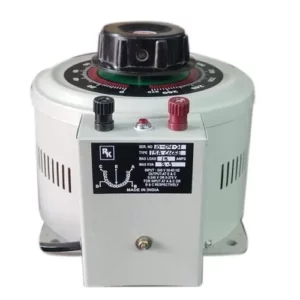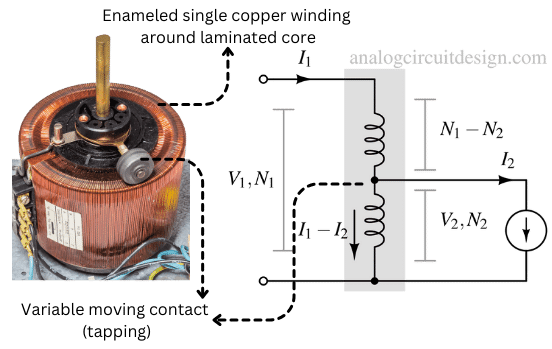The Autotransformer
What is auto transformer?¶
An autotransformer is a type of electrical transformer that has only one winding. The same winding acts as both the primary and secondary sides of the transformer. The advantage of an autotransformer is that it can be smaller, lighter, and cheaper than a conventional transformer with two separate windings. Autotransformers are commonly used for voltage regulation in laboratory and industry. These are more compact and efficient than isolation transformers but do not provide electrical isolation between the input and output.

Construction of an autotransformer¶
The construction of an autotransformer is different from a normal transformer (isolation two-winding transformer). An autotransformer has only one winding that acts as both the primary and secondary sides of the transformer. The winding is wound on a laminated magnetic core, with a rotary movable contact. The voltage ratio of the autotransformer depends on the number of turns in the common and series sections of the winding. The autotransformer can operate as a step-down or a step-up transformer by changing the connection of the input and output terminals.

Principle of operation and Voltage ratio of an autotransformer¶

Let the voltage applied across the Primary side (between A and B having N1-turns) be V1. The voltage per turn is V1/N1. So, the voltage at po\int C (secondary side having N2-turns) with respect to B is V2 :
$$V_2=\cfrac{V_1}{N_1}\times{}N_2$$
$$\cfrac{V_2}{V_1}=\cfrac{N_2}{N_1}=K$$
Copper savings in auto-transformers¶
Let's denote the weight of copper in an auto-transformer by Wauto and the weight of an isolation two-winding transformer by Wiso. The weight is proportional to the cross-section area of the copper winding which is proportional to the current. Also, it is proportional to the number of turns. In step-down condition, I2 > I1 to maintain the same power. Wauto can represented as the weight of sections AC and CB as mentioned below :
$$W_{auto}=W_{AC}+W_{CB}$$
$$W_{AC}=I_1\left(N_1-N_2\right)$$
$$W_{CB}=\left(I_2-I_1\right)N_2$$
So,
$$W_{auto}=I_1N_1+I_2N_2-2I_1N_2$$
For an isolation transformer, the total weight is :
$$W_{iso}=I_1N_1+I_2N_2$$
So, the ratio of Wiso and Wauto is :
$$\cfrac{W_{auto}}{W_{iso}}=\cfrac{I_1N_1+I_2N_2-2I_1N_2}{I_1N_1+I_2N_2}$$
We know that I2N2\=I1N1, So :
$$\cfrac{W_{auto}}{W_{iso}}=\cfrac{2I_1N_1-2I_1N_2}{2I_1N_1}$$
$$\cfrac{W_{auto}}{W_{iso}}=1-\cfrac{N_2}{N_1}=1-K$$
- Example : How much copper saving is possible in an autotransformer (in comparison to an isolation two-winding transformer) for a step-down transformer having a transformer ratio N2/N1 = K = 0.5?
Answer : Wauto = (1-K)Wiso, Wauto = (1-0.5)Wiso, Wauto = 0.5Wiso. So 50% copper saving in an autotransformer than an isolation transformer.
Properties of an auto-transformer¶
- Single Winding: Unlike a standard transformer, which has two separate windings for the primary and secondary coils, an auto-transformer has only one winding. This single winding serves both as the primary and secondary winding.
- Taps: Auto-transformers have multiple taps along the winding, allowing you to select the desired input and output voltage ratios. By connecting the input and output to different taps, you can vary the voltage transformation ratio.
- Voltage Adjustment: Auto-transformers are often used for voltage regulation purposes, such as adjusting the voltage supplied to electrical equipment. By selecting different taps, you can increase or decrease the output voltage.
- Efficiency: Auto-transformers are generally more efficient than traditional transformers because they have fewer windings and, therefore, lower resistance losses. However, this comes at the cost of no isolation between the primary and secondary circuits.
- Isolation and Safety: One significant limitation of auto-transformers is that they do not provide the same level of electrical isolation as traditional transformers. The primary and secondary windings are connected, so there is no physical separation between them. This can be a safety concern in some applications.
Advantages of an Auto-transformer¶
- It is smaller, lighter, and cheaper than a conventional two-windings transformer.
- It has higher efficiency and lower losses due to reduced leakage flux and resistance.
- It can provide a wide range of voltage regulation by adjusting the movable contact.
Disadvantages of an Auto-transformer¶
- The major drawback of an auto-transformer is that it does not offer Galvanic isolation between the primary and secondary sides. Since the autotransformer is both electrically and magnetically coupled, DC voltage at the primary side will appear directly at the secondary side.
- Any discontinuity in the primary winding would result in complete primary voltage on the secondary side, it is unsafe to use it for high voltages.
Applications of Auto-transformers¶
- Voltage Regulation: Auto transformers are frequently used for voltage regulation in electrical distribution systems. By tapping different points on the winding, you can adjust the output voltage to match the desired level, allowing for voltage stabilization and compensation for voltage drops in long-distance transmission lines.
- Variable Voltage Supplies: Auto transformers can be used to provide variable voltage supplies for testing and experimental purposes. By adjusting the tap position, you can obtain a wide range of output voltages, making them suitable for laboratory setups and adjustable voltage sources.
- Starting and Control of Motors: Auto transformers are used in motor starting applications, especially for large induction motors. They help reduce the inrush current when the motor starts, which prevents voltage sag in the power supply and minimizes mechanical stress on the motor.
- Energy Efficiency: Auto transformers can improve energy efficiency by adjusting the voltage to match the load requirements more closely. This can help reduce power losses and improve the overall efficiency of the electrical system.
- HVAC Systems: In heating, ventilation, and air conditioning (HVAC) systems, autotransformers are used to control the speed of motors in fans and pumps, allowing for variable air or fluid flow rates.
- Industrial Applications: Auto transformers find applications in various industrial processes where precise voltage control and energy efficiency are essential.